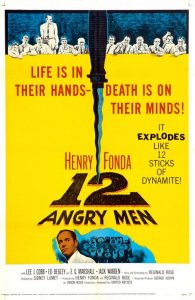
Basic Film Information
- Release date: April 13, 1957
- Director: Sidney Lumet
- Producers: Henry Fonda, Reginald Rose
- Actors: Martin Balsam, John Fiedler, Lee J. Cobb, E.G. Marshall, Jack Klugman, Edward Binns, Jack Warden, Henry Fonda, Joseph Sweeney, Ed Begley, George Voskovec, Robert Webber
Synopsis
12 Angry Men displays the the story of a jury deliberation at a murder trial. To acquit the murder, all 12 jurors must decide unanimously. Initially, only one juror supports feels the suspect is not guilty because of the reasonable doubt principle. However, after heated arguments, all jurors’ opinions are changed and the accused is free.
Contemporary Reviews
- The New York Times praised the film, stating that it was an instant classic and that the film was “powerful and provocative enough to keep a viewer spellbound.”
Background and Interesting Facts
- The film was nominated for three Oscars, but lost all to Bridge on the River Kwai (1957).
- Only two jurors are identified by name; all others are identified by their professions.
- 12 Angry Men inspired Supreme Court Justice Sonia Sotomayor to pursue a in law.
- All but three minutes of the film was shot in a single room.
Critical Analysis
In a time with heightened tensions caused by McCarthyism and the Civil Rights Movement, 12 Angry Men (1957) depicts the unsteady American courts’ jury system. Even though the jurors end the film deliberated and successfully reached a decision, 12 Angry Men showed how easily apathy of citizens ruins the system.
Only one juror took the initiative to start deliberations on the accused’s innocence. The rest, including the jury foreman, was willing to condemn the accused to death without discussion because all assumed the accused was guilty. Though it is American citizens’ civic duty and legal requirement to serve on a jury, only one took the responsibility with complete seriousness. Peer pressure was successful to persuade many jurors to converse about the accused’s guilt, but that only occurred by chance because of Juror 8’s stance. The film was created for reasons beyond entertainment or making money—director Sidney Lumet partially created the film to spread awareness about this issue with juries. One juror in the film, an immigrant, goes as far to explicitly state that “everyone must place his part” in the justice system and reminding all jurors of their patriotic duty.
However, the quick-to-blame jurors are not solely guilt for their processes in court and were not acting atypical from their time period. Instead, they were simply following the example of Joseph McCarthy—another American leader-turn-witch hunter in the early 1950’s. McCarthy rashly accused copious political figures and celebrities of being communist and ushered in the Second Red Scare. McCarthy’s quick decision making and accusations quickly condemned many. With the jurors following McCarthy’s model, they should not solely be blamed for their initial assumptions.
Just as the set in the film appears to become more compact and hot, all individuals anger and resentment increases. All jurors have a backstory, which directly impacts their voting decisions. Eventually, the jurors in the film determine the accused cannot be acquitted because reasonable doubt. This decision also displays distinct American morals. The constitution rules all citizens are innocent until proven guilty, which strongly shapes American morals. Additionally, the film reminds citizens that the justice system is not designed to take vengeance on others. For example, one juror wanted to “punish all youth for the pain and worry caused him by his own son.” He eventually realized that this punishment was inacceptable during an emotion scene.
The film also grappled with classism and racism. The jurors were quick to assume the accused was guilty, in part because he was a minority and lower class. With Brown v. Board of Education (1954) passing just before this movie was filmed, viewers were had a heightened awareness for discriminatory practices. The jury also had internal struggles throughout the film, often accusing each other on the basis of age, ethnic background, and social class. Just as the United States struggled to work through similar struggles in order to operate the country, the jury struggled to agree with their peers from different backgrounds.
However, 12 Angry Men was not a perfect representation of the 1950’s justice system. Presenting new evidence during the jury deliberation is strictly prohibited. Additionally, the jury’s decisions must be based in fact, not assumptions. While serving as a judge in lower courts, Supreme Court Justice Sonia Sotomayor even used the film as an example for the jury as what not to do. Americans should apply this film as a model for ethics and morals, not specific actions as jurors.
Despite the film’s inaccuracies, it inspired several generations of prosecutors, defense attorneys, and judges. 12 Angry Men is a highly impactful film, inspiring many viewers and forcing critical discussions. Unlike was initially occurred during the film and throughout the 1950’s, the film forced debates and discussions on justice and attempted to ensure all receive their constitutional right to a fair trial.
Bibliography
Coffey, Cindy. “12 Angry Men: A Portrait of the 1950s.” And That’s the Way It Was…. in American History, 23 April 2013.
IMDb. 12 Angry Men (1957). 2016. Web Article. 03 December 2016.
United Artists. 12 Angry Men Poster. Advertisement. Orion-Nova Productions. 1957. Web.
Semple, Kirk. “The Film That Made a Supreme Court Justice.” The New York Times, 18 October 2010, A23.
Weiler, A.H., Screen: “’12 Angry Men’; Jury Room Drama Has Debut at Capitol.” Review of 12 Angry Men, directed by Sidney Lumet, The New York Times, 15 April 1957.